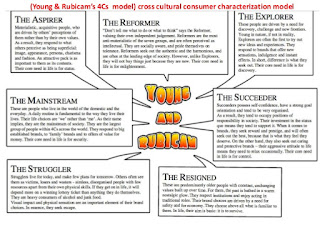Young and Rubicam's Audience Theory: The 4Cs
Young and Rubicam is a New York advertising agency who developed a theory (Cross-Cultural Consumer Characterisation Model) which categorises audiences into stereotypes reflecting their motivational needs. In order to appeal to different categories, brands and advertisers will have to use different methods and techniques to appeal to each categories’ individual motivational needs. The theory was formed as they realised that different countries have different influences due to cultural background and therefore Maslow's hirearchy of needs wasn't satisfactory. The 4cs Model is a more useful way to categorise audiences compared to the traditional demographic categorisation method which relies on jobs and class. It also acknowledged the global nature of media audiences
There are five main categories:
- Aspirers: People in this group seek status within society, and will generally consume brands that reflect their status and reputation: they will buy luxury designer brands, often using credit. Unlike reformers, aspirers are extremely materialistic. These people think of themselves as stylish, and therefore are persuaded by celebrity endorsement. Brands invested into by aspirers include expensive brands such as Gucci.
- Explorers: Explorers like to discover new things and are attracted to new, innovative brands, and new experiences. They seek discovery.
- Mainstreamers: This category holds a higher majority of people, with it being made up of 40% of the population. People categorised into this category generally consume tested brands that are value for money. Brands consumed by this category include Nike, Adidas and similar brands. They typically follow the majority and like to think they're part of a large group of like-minded people. These people will seek security.
- Reformers: Defined by self-esteem and self-improvement, reformers are not materialistic and not influenced by status, but rather by independence. They are social aware, and inclined to consume brands that are good for them (healthy), or environmentally friendly. Reformers seek enlightenment.
- Succeeders: Succeeders typically have a high social status, have control over their lives, and have nothing to prove. They believe they deserve the best, and will consume brands that are serious and reliable. People categorised as a succeeder seek control.
There are a further two categories:
- Resigned: This group is predominately an older demographic. These people will have unchanging values and attitudes that have been formed over time. They trust and believe in brands, and traditions, that are familiar to them; their brand choices are driven by a need for safety and economy. People in the resigner category will generally find a brand that the like, and will stick and consume that brand for a long period of time. These people generally tend to just seek to survive.
- Strugglers: Strugglers have a 'live for the day' attitude, and have little thought about the future. Strugglers may see themselves as victims, and losers, who are aimless, disorganised people with few resources apart from their own physical skills. They believe more in fate and luck rather than being responsible. Strugglers’ brand consumption choices will factor down to visual impact, and physical sensation. These people are typically larger consumers of alcohol and junk food, and they'll seek escape.
Examples:
Aspirers;Mainstreamers;
Apple's advert for the iPhone 7 is guaranteed to gain the attention of mainstreamers as the advert displays various different people using the phone, and mainstreamers will them be motivated to buy the iPhone as other people have it and they want to fit it.
Reformers;
Sarah McLachlan, a Canadian singer and songwriter, released the song World On Fire in the 2000s, alongside the video. The music video may engage audiences who are reformers as although at the start, it's claimed that the video cost $150,000, although the video actually only cost $15. Throughout the video, it's shown what better use $150,000 could be put towards, and promotes donating and charity work. Many music artists would have spent a ridiculous amount of money on their music video to make it better quality, since it's thought that the more money spent, the better it will be which doesn't always work out.
Reformers;

Comments
Post a Comment